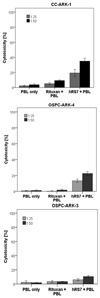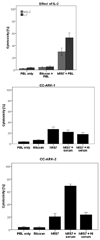High-grade, chemotherapy-resistant primary ovarian carcinoma cell lines overexpress human trophoblast cell-surface marker (Trop-2) and are highly sensitive to immunotherapy with hRS7, a humanized monoclonal anti-Trop-2 antibody
- PMID: 21453957
- PMCID: PMC3104081
- DOI: 10.1016/j.ygyno.2011.03.002
High-grade, chemotherapy-resistant primary ovarian carcinoma cell lines overexpress human trophoblast cell-surface marker (Trop-2) and are highly sensitive to immunotherapy with hRS7, a humanized monoclonal anti-Trop-2 antibody
Abstract
Objective: We evaluated the expression of human trophoblast cell-surface marker (Trop-2) and the potential of hRS7, a humanized monoclonal anti-Trop-2 antibody, as a therapeutic agent against chemotherapy-resistant ovarian disease.
Methods: Trop-2 expression was evaluated by immunohistochemistry (IHC) in 50 ovarian serous papillary carcinoma specimens. Trop-2 expression was also evaluated by real-time PCR (qRT-PCR) and flow cytometry in a total of 6 primary ovarian cancer cell lines derived from patients with chemotherapy-resistant disease. Sensitivity to hRS7 antibody-dependent cellular cytotoxicity (ADCC) was tested in standard 5-hour ⁵¹Cr-release assays. The effect of serum and interleukin-2 (IL-2) on hRS7-mediated ADCC was also studied.
Results: Trop-2 expression was found in 41 of 50 (82%) tumor tissues tested by IHC. 83% (5 of 6) of the ovarian cancer cell lines tested by qRT-PCR and flow cytometry demonstrated high Trop-2 expression. All primary ovarian cancer cell lines expressing Trop-2 were highly sensitive to hRS7-mediated ADCC in vitro (range of killing: 19.3% to 40.8%) (p<0.001). Negligible cytotoxicity against chemotherapy-resistant ovarian cancers was seen in the absence of hRS7 or in the presence of rituximab control antibody (range of killing: 1.1% to 8.9%). Human serum did not significantly inhibit hRS7-mediated cytotoxicity while incubation with IL-2 in addition to hRS7 further increased the cytotoxic activity (p=0.04).
Conclusions: Trop-2 is highly expressed in chemotherapy-resistant ovarian cancer cell lines at mRNA and protein levels. Primary ovarian carcinoma cell lines are highly sensitive to hRS7-mediated cytotoxicity in vitro. hRS7 may represent a novel therapeutic agent for the treatment of high-grade, chemotherapy-resistant ovarian cancer.
Copyright © 2011 Elsevier Inc. All rights reserved.
Figures



Similar articles
-
Uterine serous papillary carcinomas overexpress human trophoblast-cell-surface marker (Trop-2) and are highly sensitive to immunotherapy with hRS7, a humanized anti-Trop-2 monoclonal antibody.Cancer. 2011 Jul 15;117(14):3163-72. doi: 10.1002/cncr.25891. Epub 2011 Jan 18. Cancer. 2011. PMID: 21246534 Free PMC article.
-
Cervical carcinomas overexpress human trophoblast cell-surface marker (Trop-2) and are highly sensitive to immunotherapy with hRS7, a humanized monoclonal anti-Trop-2 antibody.Am J Obstet Gynecol. 2011 Dec;205(6):567.e1-7. doi: 10.1016/j.ajog.2011.06.093. Epub 2011 Jul 13. Am J Obstet Gynecol. 2011. PMID: 21889762 Free PMC article.
-
Trop-2 overexpression in poorly differentiated endometrial endometrioid carcinoma: implications for immunotherapy with hRS7, a humanized anti-trop-2 monoclonal antibody.Int J Gynecol Cancer. 2011 Dec;21(9):1613-21. doi: 10.1097/IGC.0b013e318228f6da. Int J Gynecol Cancer. 2011. PMID: 21892093 Free PMC article.
-
Recent advances in trophoblast cell-surface antigen 2 targeted therapy for solid tumors.Drug Dev Res. 2021 Dec;82(8):1096-1110. doi: 10.1002/ddr.21870. Epub 2021 Aug 30. Drug Dev Res. 2021. PMID: 34462935 Review.
-
Immunoglobulin-like cell adhesion molecules: novel signaling players in epithelial ovarian cancer.Int J Biochem Cell Biol. 2010 May;42(5):590-4. doi: 10.1016/j.biocel.2010.01.017. Epub 2010 Jan 18. Int J Biochem Cell Biol. 2010. PMID: 20083222 Review.
Cited by
-
Monocytes and the 38kDa-antigen of mycobacterium tuberculosis modulate natural killer cell activity and their cytolysis directed against ovarian cancer cell lines.BMC Cancer. 2012 Oct 4;12:451. doi: 10.1186/1471-2407-12-451. BMC Cancer. 2012. PMID: 23036052 Free PMC article.
-
Sacituzumab govitecan, an antibody-drug conjugate targeting trophoblast cell-surface antigen 2, shows cytotoxic activity against poorly differentiated endometrial adenocarcinomas in vitro and in vivo.Mol Oncol. 2020 Mar;14(3):645-656. doi: 10.1002/1878-0261.12627. Epub 2020 Jan 14. Mol Oncol. 2020. PMID: 31891442 Free PMC article.
-
Ultrasound‑targeted microbubble destruction‑mediated overexpression of Sirtuin 3 inhibits the progression of ovarian cancer.Oncol Rep. 2021 Oct;46(4):220. doi: 10.3892/or.2021.8171. Epub 2021 Aug 13. Oncol Rep. 2021. PMID: 34396428 Free PMC article.
-
Trop-2 is a novel target for solid cancer therapy with sacituzumab govitecan (IMMU-132), an antibody-drug conjugate (ADC).Oncotarget. 2015 Sep 8;6(26):22496-512. doi: 10.18632/oncotarget.4318. Oncotarget. 2015. PMID: 26101915 Free PMC article.
-
Mammaglobin B (SCGB2A1) is a novel tumour antigen highly differentially expressed in all major histological types of ovarian cancer: implications for ovarian cancer immunotherapy.Br J Cancer. 2013 Jul 23;109(2):462-71. doi: 10.1038/bjc.2013.315. Epub 2013 Jun 27. Br J Cancer. 2013. PMID: 23807163 Free PMC article.
References
-
- Jemal A, Siegel R, Xu J, Ward E. Cancer statistics, 2010. CA Cancer J Clin. 2010;60:277–300. - PubMed
-
- Martin LP, Schilder RJ. Management of recurrent ovarian carcinoma: current status and future directions. Semin Oncol. 2009;36:112–125. - PubMed
-
- Miotti S, Canevari S, Menard S, Mezzanzanica D, Porro G, Pupa SM, et al. Characterization of human ovarian carcinoma-associated antigens defined by novel monoclonal antibodies with tumor-restricted specificity. Int J Cancer. 1987;39:297–303. - PubMed
MeSH terms
Substances
Grants and funding
LinkOut - more resources
Full Text Sources
Other Literature Sources
Medical
Research Materials
Miscellaneous

